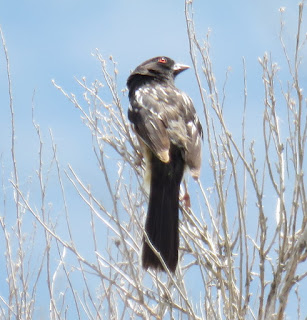July 22
It was a longer drive to the North unit and it is smaller
and less visited. The lady that took my ID for the Senior pass said “you look
so young in this photo”. Greg says “it expires this year.” I said, “yes, the
photo will look much different this time.” (10 years later)
Mountain Bluebird in the parking lot
Mountain Bluebird
start of the scenic drive loop
The vistas here may be prettier & more dramatic than the
South Unit. You are much closer to the sandstone. They have a 14 mile scenic
drive.
Lark Sparrow
Lark Sparrow
Swainson's Hawk
Swainson's Hawk
Swainson's Hawk
Eastern Kingbird
Mule Deer
Mule Deer
Spotted Towhee
Eastern Bluebird
Eastern Bluebird
Oxbow Overlook - A short, paved path along the rim of the badlands with sweeping views of the Little Missouri River and distant Achenbach Hills.
Eastern Bluebird
Mountain Bluebird - female
Least Flycatcher
Mountain Bluebird
Eastern Bluebird
Eastern Bluebird
Cedar Waxwing
Mountain Bluebird
Mountain Bluebird - female
we were driving up a hill when this came into view
Yellow Chat
House Finch
Western Meadowlark
Western Meadowlark
House Finch
Northern Flicker - Yellow Shafted
River Bend Overlook - a viewing deck of one of the park’s most iconic views - Greg in front of the overlook shelter
my hair says it's windy up there
back on the loop road - Buffalo high up on a hill
American Kestrel
Spotted Towhee
There are no Prairie Dogs that can be seen from the drive, but there is
a trail that leads to a Prairie dog Town. Since we saw so many yesterday, we took
the alternate trail that went back in between the badlands. We took the Caprock Coulee Nature Trail which was 1.4 miles in a shady coulee.
Spotted Towhee
Greg on the trail
evidence that a buffalo had been here
Caprock
We brought another picnic lunch and drove the loop twice. One of the stops is at Cannonball Concretions pullout.
Cannonballs are large, spherical sandstone concretions. They are seldom greater than two to three feet in diameter. Like most other concretions, they are more resistant to weathering than enclosing sediments and often can be found at the base of slopes.
The cannonballs formed by cementation, with calcium carbonate being the principal cementing agent They may contain a small nucleus of organic material (a shell or plant fragment). Their spherical form suggests that growth was unconstrained by primary sedimentary structures or fabrics, such as would be the case for more flattened or irregularly shaped concretions.
Cannonball Concretions
Greg taking a photo of me taking a photo
Our last walk was the Little Mo Nature Trail along the Little Missouri River.
female Orchard Oriole
Downy Woodpecker
Downy Woodpecker
Cedar Waxwing
female Orchard Oriole
House Wren
unknown
Cedar Waxwing
As
we were driving out we saw a herd of Bison making their way up a butte. Very
interesting to see them make their way up. There was one young calf that I
think has some physical issues. Its’ hind quarters were sloped down and it was
having a very hard time walking much less gong up the hill. Its’ mother was right
behind it and so patient. She didn’t help it, just let it make its’ own way in
its' own time.
this was the other young one - it looked healthy
this is the young one that was having challenges going up the butte
The North Unit also has some Longhorn Cattle. Theodore Roosevelt arrived in Medora just as the cattle
ranching boom was beginning, and the extermination of bison in the west was
coming to an end. At the time, cattle drives were a common sight on the plains
as cowboys moved herds of longhorn and other cattle from as far away as Texas
to fresh pastures in the Dakota Territory. The Long X Trail, which passed
through what is now the North Unit of Theodore Roosevelt National Park, was one
of several routes cowboys used to drive their cattle north. Roosevelt became
enamored with the landscape and the cowboy lifestyle, and invested in his own
cattle ranching operations through the late-1880s. To reflect the living landscape
as Roosevelt experienced it, the Park maintains a small demonstration herd of
longhorn steers in the North Unit.
We drove home and ate dinner and went to bed early for a 6:30
start tomorrow to go back to the South Unit in hopes of finding Elk.
































































































































































No comments:
Post a Comment